All work associated with removal of the first of four hydroelectric dams slated for demolition on the Klamath River completed in early November, according to the dam owner, Klamath River Renewal Corp. Demolition of the four dams on the Klamath River that flows through parts of Oregon and California is the largest dam removal project in U.S. history.
The dismantling of Copco No. 2, a 35-ft concrete diversion dam in California, is a milestone for project advocates, who include local tribes concerned about destruction of the habitat for once plentiful salmon and steelhead trout populations in the Klamath River basin.
All four dams are expected to be removed by November 2024—an event that caps more than two decades of regulatory and legal disputes between its former owner, stakeholders and states over licensing and environmental permits.
“It was a pretty ambitious goal to remove four large dams,” Craig Tucker, natural resources policy advocate for the Karuk Tribe, told ENR. “It took 20 years of hard-nosed campaigning and advocacy. In the end, [former dam owners] PacifiCorp and Berkshire Hathaway sat down and negotiated a settlement agreement with the Klamath tribes that is today leading to the biggest dam removal and restoration project in world history.”
PacifiCorp relinquished its license to operate the dams to the nonprofit Klamath River Renewal Corp. (KRRC), which is overseeing their demolition to restore access for fish populations to their natural spawning habitats. The $450-million design-build project, awarded to Kiewit Infrastructure West in 2019, includes restoring river channels, tributaries and reservoir footprints and is largely funded by the California and Oregon, with PacifiCorp contributing $200 million.
The Federal Energy Regulatory Commission approved the license transfer to KRRC in November 2022, and work began in June on Copco No. 2, the smallest of the four dams. KRRC decided to remove it first because of its size, location and lack of a reservoir, according to Mark Bransom, the non-profit's CEO. “While Copco No. 2 is significantly smaller than the other dams slated for removal, it still had a significant impact on the river,” he said in a statement.

Trees grew in parts of the channel where Copco No. 2 diverted water from the river. Because the trees would die once the dam was demolished, the trees were removed as part of the project.
Photo Courtesy of Klamath River Renewal Corp.
Restoring Flows to a Dewatered Canyon
Copco No. 2, built in 1925, was located just downstream of the larger Copco No. 1 dam in an area known as Ward’s Canyon. The smaller dam diverted water from the river and funneled it downstream to a powerhouse station for Copco No. 1. Because the water was diverted from a 1.7-mile stretch of the river for nearly a century, trees grew in the dewatered area of the canyon. Those trees, if not removed, would die and potentially cause a risk to people using the river for recreational purposes once water began to flow through the channel, KRRC says.
In June, crews cut off water flowing from Copco No. 1 upstream to the smaller concrete dam and began demolition. After major work finished in September, the remaining diversion infrastructure was removed and river grading and erosion control added. The channel restoration and tree removal by helicopter was completed in early November.
What’s Ahead
Work on the three other dams will begin in January, with simultaneous drawdown of three impounding reservoirs, and is expected to take three to five months depending on how much rain and snow fall in the Klamath basin this winter and spring. Each dam will be breached and dismantled according to its original construction in a kind of reverse engineering, with work to be done on all three structures at the same time. Crews expect to finish the project before the end of 2024.
Located in Oregon furthest upstream from the Pacific, the J.C. Boyle dam is a 68-ft combination embankment and concrete structure with a two-mile concrete power canal and twin 1,000-ft-high penstocks.
Crews there are testing and improving an existing outlet tunnel originally used to divert water during dam construction in 1958. They will blast out an upstream stoplog plug in early January to drain the reservoir beneath the existing spillway. In late spring and summer when flows are lowest, construction crews will demolish the dam using large excavator-mounted hydraulic hammers. Earthen material and concrete rubble will be returned to a scour hole that formed at the base of the diversion spillway to restore the river channel to its original configuration.
Thirty miles downstream, Copco No. 1 is 126-ft high concrete gravity arch dam built in 1918. To drain the reservoir, crews will drill and blast a 10-ft-dia., 90-ft-long outlet tunnel through concrete. Construction crews will dismantle the dam using drills and dynamite to break up the structure and haul away concrete, including the original foundation, to remove potential fish barriers. A new river channel will be built in the existing dam footprint.
Farthest downstream is the largest of the three dams, Iron Gate. Completed in 1962, it is a 173-ft high earthfill dam with a diversion tunnel at its base. Crews will make improvements to the tunnel to begin drawdown in January that will handle flow of all three reservoirs. In late spring or early summer 2024, excavation equipment will dig out the structure from the top down. A convoy of large dump trucks will ferry material to fill a “borrow pit” where material was originally extracted to build the dam.
In addition to dam removal, crews will also dismantle the powerhouses, penstocks and outbuildings, recycle steel and dispose of hazardous material.
Project total numbers as estimated by KRRC are impressive: Kiewit will demolish and remove 100,000 cu yd of concrete and 2,000 tons of steel, and excavate 1.3 million cu yd of earthen material.
The construction project will employ 250 to 300 workers, including local and tribal subcontractors. The main contractor for habitat restoration is Resource Environmental Solutions. Working in conjunction with the Yurok Tribe, the project team will plant millions of seeds in the reservoir footprint as water recedes.
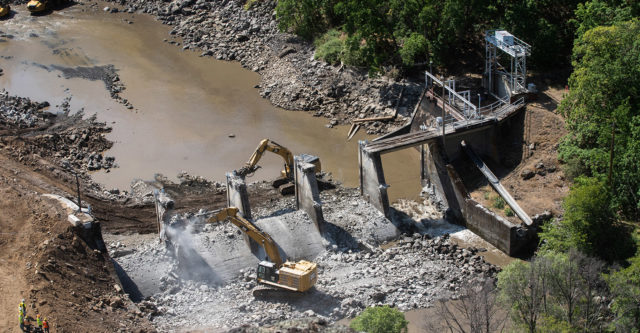




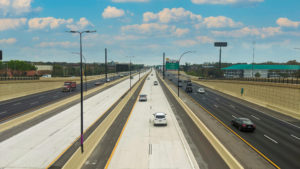

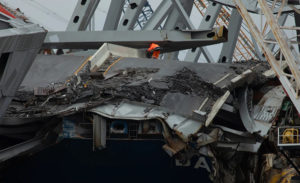
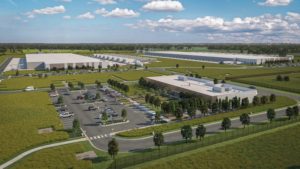
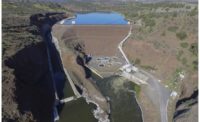
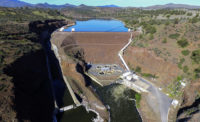
Post a comment to this article
Report Abusive Comment